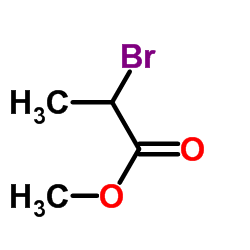2-溴丙酸甲酯

2-溴丙酸甲酯结构式

|
常用名 | 2-溴丙酸甲酯 | 英文名 | Methyl 2-bromopropionate |
|---|---|---|---|---|
| CAS号 | 5445-17-0 | 分子量 | 167.001 | |
| 密度 | 1.5±0.1 g/cm3 | 沸点 | 145.9±8.0 °C at 760 mmHg | |
| 分子式 | C4H7BrO2 | 熔点 | N/A | |
| MSDS | 中文版 美版 | 闪点 | 51.7±0.0 °C | |
| 符号 |



GHS02, GHS05, GHS07 |
信号词 | Danger |
|
Design and synthesis of digitally encoded polymers that can be decoded and erased.
Nat. Commun. 6 , 7237, (2015) Biopolymers such as DNA store information in their chains using controlled sequences of monomers. Here we describe a non-natural information-containing macromolecule that can store and retrieve digital information. Monodisperse sequence-encoded poly(alkoxyami... |
|
|
The first proton sponge-based amino acids: synthesis, acid-base properties and some reactivity.
Org. Biomol. Chem. 13 , 8524-32, (2015) The first hybrid base constructed from 1,8-bis(dimethylamino)naphthalene (proton sponge or DMAN) and glycine, N-methyl-N-(8-dimethylamino-1-naphthyl)aminoacetic acid, was synthesised in high yield and its hydrobromide was structurally characterised and used t... |
|
|
Synthesis of hollow mesoporous silica nanoparticles with tunable shell thickness and pore size using amphiphilic block copolymers as core templates.
Dalton Trans. 43(31) , 11834-42, (2014) This paper presents a facile method for the fabrication of uniform hollow mesoporous silica nanoparticles (HMSNs) with tunable shell thickness and pore size. In this method, a series of amphiphilic block copolymers of polystyrene-b-poly (acrylic acid) (PS-b-P... |
|
|
Polymer brushes on single-walled carbon nanotubes by atom transfer radical polymerization of n-butyl methacrylate.
J. Am. Chem. Soc. 126(1) , 170-6, (2004) Polymer brushes with single-walled carbon nanotubes (SWNT) as backbones were synthesized by grafting n-butyl methacrylate (nBMA) from the ends and sidewalls of SWNT via atom transfer radical polymerization (ATRP). Carboxylic acid groups on SWNT were formed by... |
|
|
2-18F-Fluoropropionic acid as a PET imaging agent for prostate cancer.
J. Nucl. Med. 50(10) , 1709-14, (2009) There is a high interest in developing an (18)F-labeled PET tracer that can aid in diagnosis and therapy monitoring of prostate cancer. In the current study, we have evaluated the potential of 2-(18)F-fluoropropionic acid ((18)F-FPA) as a PET tracer for imagi... |